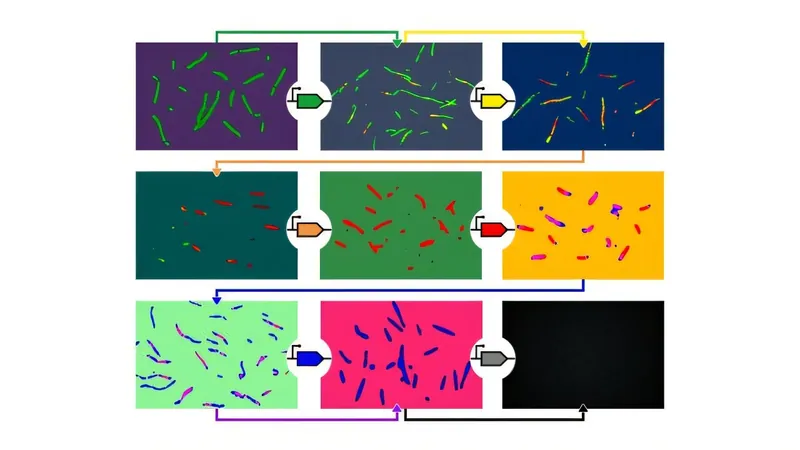
Revolutionary Synthetic Genes: The Building Blocks of Life Just Got a Makeover!
2024-11-04
Author: Sarah
Introduction
In an extraordinary breakthrough, researchers from UCLA Samueli School of Engineering and Italy’s University of Rome Tor Vergata have successfully created synthetic genes that mimic the behavior of natural genes in living organisms. This innovative technology represents a pivotal advancement in synthetic biology, providing a modular approach to constructing complex intracellular structures.
The Mechanism Behind Synthetic Genes
Similar to assembling furniture from an IKEA kit, these synthetic genes function through a cascading process that allows for the step-by-step formation of self-assembling structures. This method not only facilitates the construction of intricate materials, such as nanoscale tubes made from DNA tiles, but it also allows these structures to be deconstructed and reconfigured effortlessly.
Expert Insights
Elisa Franco, a mechanical and aerospace engineering professor at UCLA and the lead researcher, stated, "Our work suggests a way toward scaling up the complexity of biomolecular materials by manipulating the timing of molecular instructions for self-assembly—rather than merely increasing the number of molecules that relay those instructions." This innovative approach opens doors to generating diverse materials that could spontaneously emerge from a limited set of components, simply by reordering their assembly timeline.
Biological Inspiration
The implications of this research echo through the fields of biology and engineering. Organisms typically develop from a single cell through a series of carefully timed and regulated gene activations. For instance, the body segment formation in fruit flies is controlled by a precise gene cascade, a process that the researchers aimed to emulate in their laboratory.
Research Vision
Francesco Ricci, a chemical sciences professor and co-author of the study, explained their vision: "We envisioned recreating lab-scale gene cascades that could either initiate the assembly or disassembly of synthetic materials based on the timing of gene activation."
Experimental Findings
In their study, a mixture of synthetic DNA strands served as the building blocks for DNA tiles, which collectively interacted in a solution to form micron-scale tubular structures. These structures were formed in response to specific RNA molecules that acted as triggers. Remarkably, another RNA trigger could prompt the disassembly of these very structures, highlighting the versatility of this synthetic system.
Precision Control
By programming various synthetic genes to produce RNA triggers at designated intervals, researchers orchestrated the formation and dissolution of DNA structures with impressive precision. The resulting synthetic genetic cascade shares similarities with natural biological processes but also offers unique capabilities, including controlling the properties of the structures created.
Future Applications
“Our approach is not limited to DNA; it has promising applications across various materials and systems dependent on biochemical timing,” stated Daniela Sorrentino, a postdoctoral researcher and the study's first author. “We envision materials that evolve spontaneously from the same components, heralding promising advancements in synthetic biology and paving new avenues in medical and biotechnological applications.”
Conclusion
This groundbreaking research, recently published in *Nature Communications*, is set to revolutionize how we approach synthetic materials, with potential implications ranging from drug delivery systems to advanced biomimetic materials. The future of synthetic biology is exciting, as scientists unlock the power of modular design in the creation of life-like structures, enabling possibilities we once only dreamt of.



 Brasil (PT)
Brasil (PT)
 Canada (EN)
Canada (EN)
 Chile (ES)
Chile (ES)
 Česko (CS)
Česko (CS)
 대한민국 (KO)
대한민국 (KO)
 España (ES)
España (ES)
 France (FR)
France (FR)
 Hong Kong (EN)
Hong Kong (EN)
 Italia (IT)
Italia (IT)
 日本 (JA)
日本 (JA)
 Magyarország (HU)
Magyarország (HU)
 Norge (NO)
Norge (NO)
 Polska (PL)
Polska (PL)
 Schweiz (DE)
Schweiz (DE)
 Singapore (EN)
Singapore (EN)
 Sverige (SV)
Sverige (SV)
 Suomi (FI)
Suomi (FI)
 Türkiye (TR)
Türkiye (TR)
 الإمارات العربية المتحدة (AR)
الإمارات العربية المتحدة (AR)